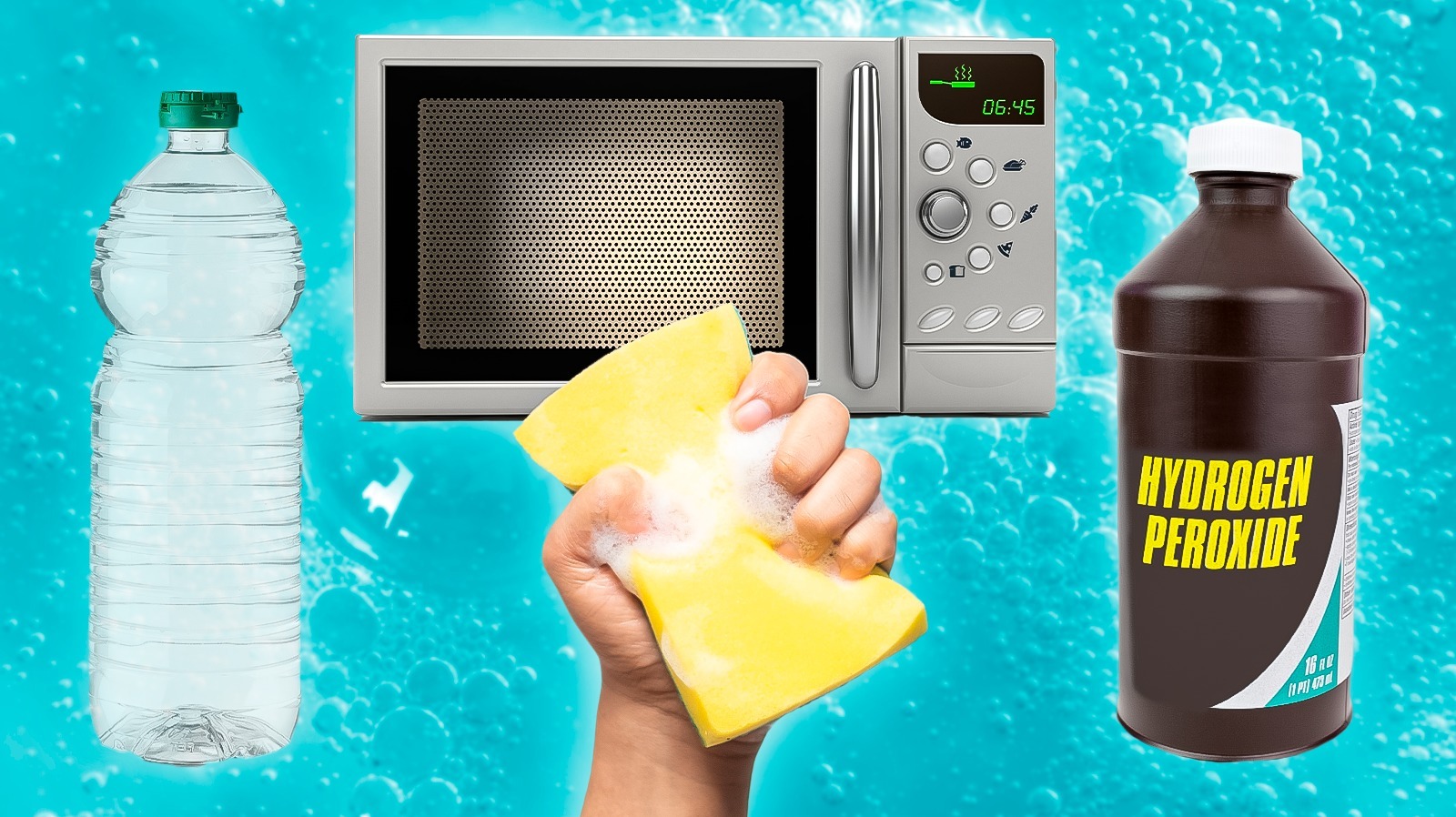The sponge you use to wipe up kitchen spills, wash your dishes, and clean your sink just might be the dirtiest thing in your whole house. Washing your hands is standard operating procedure in the kitchen, and sanitizing and frequently replacing your sponge are equally important tasks that should become a regular part of your cleaning routine. A dirty sponge can do much worse than just stink up your kitchen — it can be a breeding ground for bacteria. In fact, a 2017 study published by Nature states that “kitchen environments host more microbes than toilets … mainly due to the contribution of kitchen sponges, which were proven to represent the biggest reservoirs of active bacteria in the whole house.”
Bacteria like salmonella and staphylococcus can live in sponges, and these pathogens can be transferred onto surfaces that your sponge comes in contact with, leaving a trail of microbes that could potentially lead to foodborne illness. But there are ways to minimize the amount of bacteria your sponge collects. You can start by not using your sponge to wipe up messy spills or clean your countertops. Any bacteria in those spills can accumulate in your sponge and then spread to your kitchen surfaces and even your food. Use your kitchen sponge only for washing dishes, and replace it frequently for the safest results. You can also clean your kitchen sponge to minimize bacteria growth and cross-contamination. Here are some ways to do that and help keep your kitchen safe.
Soak your sponge in lemon juice
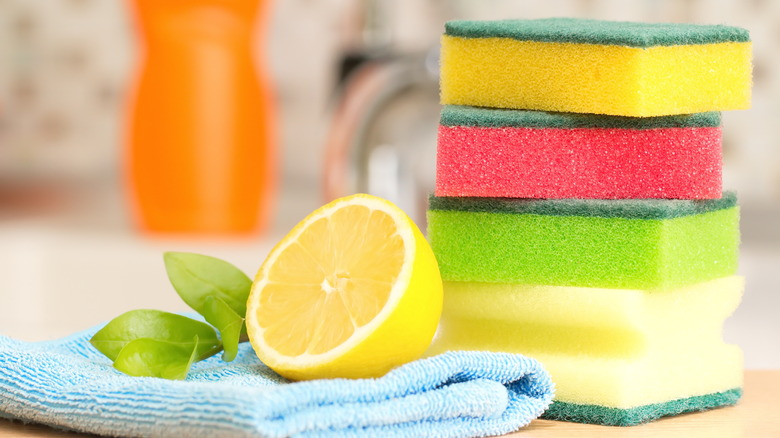
Lemons have always had a place in the kitchen, typically as an ingredient. A splash of freshly squeezed lemon juice can lift the flavor of everything from a bowl of chicken soup to a plate of spaghetti to sweet lemon bars. You can also use lemon juice to enhance taste, which is why many restaurants add a slice of lemon to your glass of water and tuck a lemon wedge onto your plate. Yes, it’s nice to look at, but there’s also a practical reason lemons are used in this fashion. Like salt, you can boost flavor with lemon, making each ingredient taste like the most delectable version of itself.
Cleaning is another practical household use for lemons, especially in messy kitchens that can benefit from lemons in many ways. The bright, fresh scent of lemon can neutralize bad fridge odors, while lemon juice is a crucial substance in hacks to clean your kitchen sink — and it can help revitalize your kitchen sponge.
Pure lemon juice contains properties that impede bacteria growth, including E. coli, which causes severe abdominal ailments. Soaking your sponge in lemon juice for at least one minute is a non-toxic way to wipe out germs and improve the smell of your sponge.
Disinfect your sponge with bleach
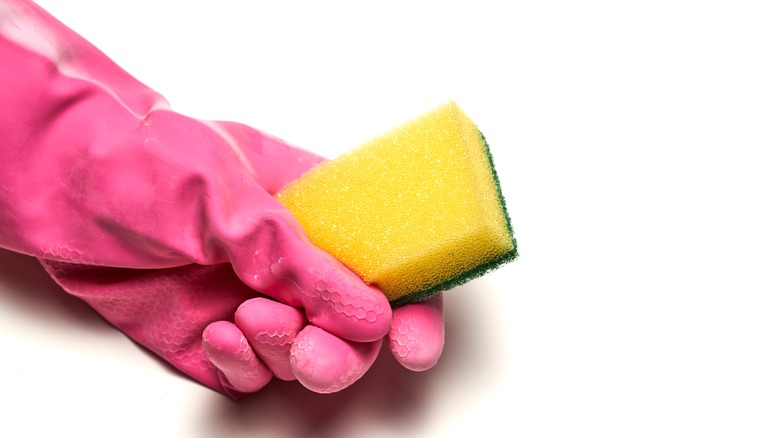
Soap and water is sufficient to clean surfaces, getting rid of dirt and germs — but if you want to disinfect surfaces and destroy dangerous bacteria, choose bleach. To keep your sponge from spreading harmful pathogens around your kitchen, reach for the bleach you likely already have in your cleaning arsenal.
Bleach eliminates bacteria and viruses. It’s especially effective at killing microbes that can cause illness. Consider it your not-so-secret weapon in sanitizing your kitchen sponge and keeping your kitchen safe. To make sure you’re not turning your kitchen into a petri dish, soak your kitchen sponge in bleach at least once a week to sanitize it.
According to a U.S. Department of Agriculture report, soaking your kitchen sponge in a 10% bleach solution (1 part bleach and 9 parts water) for three minutes reduces the amount of bacteria present. Good Housekeeping confirmed that bleach is a good option for disinfecting kitchen sponges, after finding that soaking a sponge in a mix of bleach and water for as little as five minutes eliminated 99.9% of bacteria present.
Submerge your sponge in boiling water
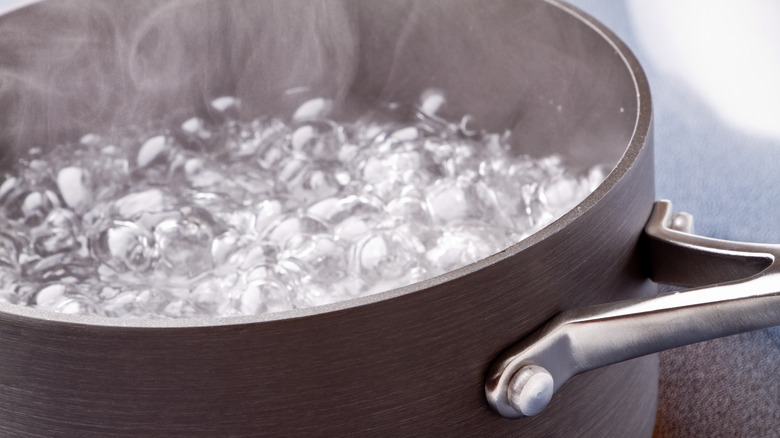
Boiling water is used in many ways around the house. You can use it to remove tough stains, clear clogged pipes, and even kill weeds. In the kitchen, it’s how we cook eggs, rice, and pasta. It’s the basis for a hot cup of tea — and it provides an easy way to clean your dirty kitchen sponge.
To disinfect your kitchen sponge, bring a pot of water to a rolling boil. Make sure you start with enough water to cover the sponge completely. Carefully drop the sponge in the water and use tongs to push it below the surface. It’s imperative that the sponge be fully submerged in the water. Boil the sponge for at least five minutes and up to seven minutes before removing it from the hot water. Use your tongs to grab the sponge and squeeze out excess water.
Alternatively, you can place your sponge in a bowl and pour boiling water over it. Add enough water to cover the sponge and ensure that it’s fully immersed. Let the sponge sit in the water for at least five minutes before removing it. It’s essential to make sure the water comes to a complete boil, or 212 F, in order to clean your sponge properly and kill the germs lurking within it.
Zap your sponge in the microwave
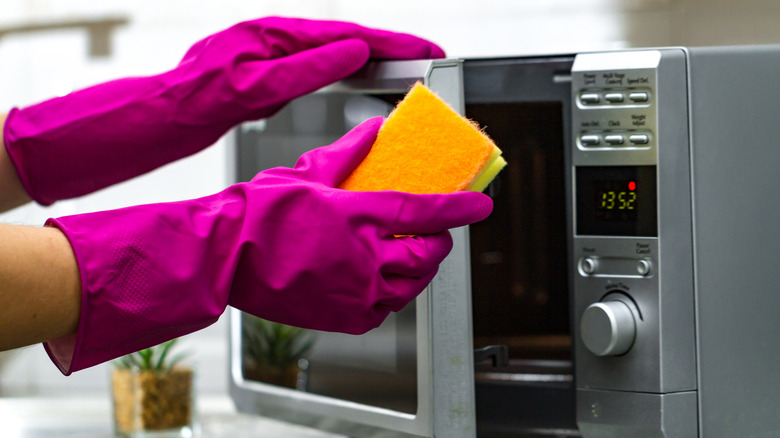
goffkein.pro/Shutterstock
The USDA reports that microwaving your kitchen sponge can kill up to 99.99999% of bacteria present. That’s significant given that the most common bacteria found in kitchen sponges include some of the most dangerous, like E. coli, salmonella, and staphylococcus aureus. These bacteria can cause a range of unpleasant and nasty conditions like diarrhea, staph infection, and food poisoning.
Popping your sponge in the microwave can significantly reduce the amount of the bacteria it harbors. In fact, the Environmental Protection Agency recommends microwaving your sponges for two minutes every day to keep them clean. When sponges are microwaved at 100% power, it only takes 30 seconds to kill E. Coli. Sponges microwaved for two minutes experience a 99% reduction in bacteria.
To clean your kitchen sponge in the microwave, first check the label on your sponge’s packaging to make sure it is microwave-safe. Sponges with abrasive surfaces used for scrubbing could contain bits of metal, making them unsafe for microwave use. Wet the sponge and place it in a microwave-safe bowl. Place the bowl in the microwave and zap it on 100% power for at least a minute. Take the sponge out of the microwave and set it aside until it’s cool enough to touch safely.
Clean your sponge in the dishwasher
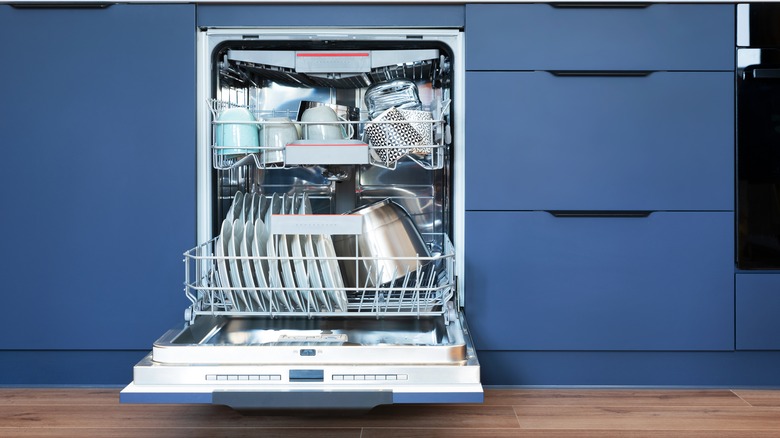
The dishwasher might be the most convenient appliance ever. It makes cleaning up after cooking a meal a breeze, and it can even be used for several other household tasks, like cleaning baseball caps, washing removable shelves and drawers from your refrigerator, and even freshening up makeup brushes. (However, contrary to the advice of varied online articles, the dishwasher is not a good method for cleaning potatoes.)
You can also put your dishwasher to use for keeping your kitchen sponges clean. Using the dishwasher to clean sponges is easy and efficient. You can simply add your sponge to your dishwasher when you run the machine as part of your regular cleaning routine. All types of sponges are safe to clean in the dishwasher, even those with hard surfaces built for scrubbing away tough stains and food.
According to the USDA, placing your dirty kitchen sponge in the dishwasher can kill up to 99.9998% of its bacteria. To use the dishwasher to clean your kitchen sponge, first rinse the sponge and remove any bits of food or debris. Place the sponge on the top shelf of your dishwasher and run it on the heated dry option, if your dishwasher has this feature. Use the dishwasher setting with the longest washing time and the highest temperature setting for best results.
Refresh your sponge with hydrogen peroxide
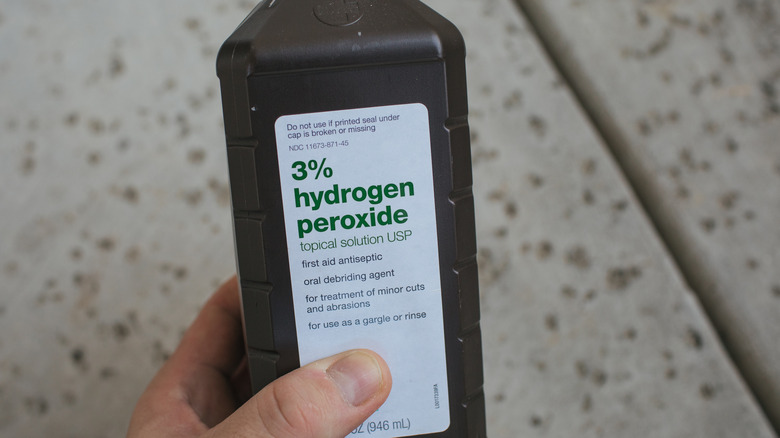
Add hydrogen peroxide to the list of items you may have around your house that can be used to keep your kitchen sponges clean. Hydrogen peroxide is a clear liquid that was once used as a treatment for cleaning and disinfecting cuts, scrapes, and other wounds. Today, many experts believe hydrogen peroxide can cause more damage than good when used on wounds. But there is no question about hydrogen peroxide’s ability to kill germs.
You can clean your kitchen sponge with hydrogen peroxide in just a few minutes. Place the sponge in a small container and add equal parts hydrogen peroxide and water, to the point of fully submerging the sponge. Let the sponge soak for at least 15 minutes, flipping if necessary to ensure the solution is absorbed on both sides. According to the Centers for Disease Control and Prevention, 3% hydrogen peroxide, the kind most commonly available, can kill the virus that causes the common cold in six to eight minutes. It’s also effective at killing bacteria and molds.
Hydrogen peroxide should not be used on or near surface countertops like granite and marble. It can damage the stone’s finish and cause discoloration, so use it with caution. This disinfectant can cause damage to your skin and eyes if they’re exposed to it directly, so be careful when working with it.
Drench your sponge in salt water
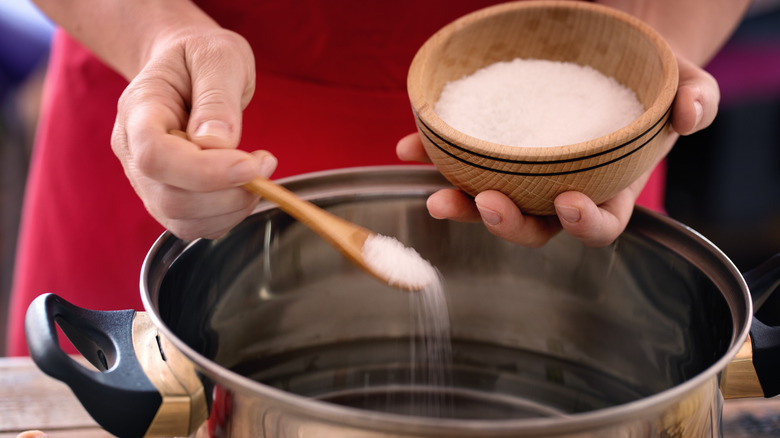
Salt is known as a flavor enhancer. Sprinkle a few grains over just about any food, and it will taste like the very best version of itself. Off the plate, there are many unexpected uses for salt. Sprinkle it liberally over fresh carpet stains; the salt will draw out the moisture and the stains from the fabric. Use coarse kosher salt as an abrasive cleaner to remove tough stains from pots and pans.
Salt is also suitable for killing some strains of bacteria. Salt pulls moisture out of bacteria in the same way it pulls moisture from food and red wine stains. This kills the bacteria cells because they can’t function without water. Salt can eliminate bacteria like E. coli, but other microbes like staphylococcus can survive in a salty environment. Use a secondary method of cleaning your sponge to address bacteria that are resistant to salt.
To clean your kitchen sponge, dissolve a quarter cup of salt in a quart of warm water. Make sure the salt is completely dissolved before you add the sponge. Smaller grains of salt, like table salt, will dissolve faster when added to the water. Let the sponge soak in the salt water overnight. Remove it from the salt water and rinse it thoroughly, removing any remaining salt. If possible, allow the sponge to dry completely before using.
Spray your sponge with essential oils
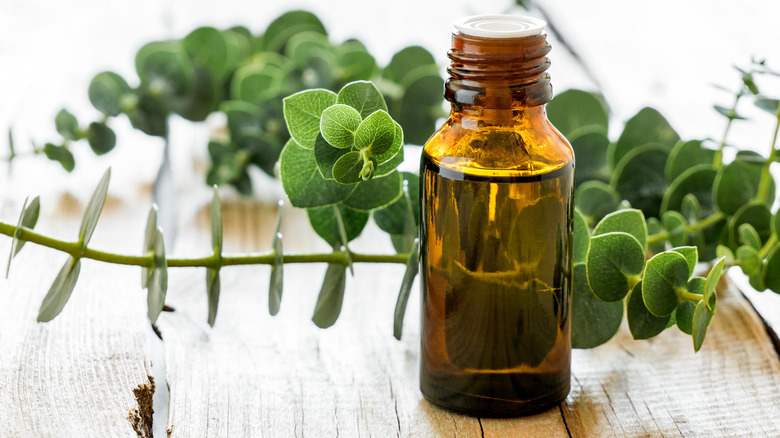
Essential oils are extracted from plants and are known for their perfume-like scents. They’re the key ingredient in aromatherapy, which uses essential oils for healing purposes. Many people rely on essential oils to help with numerous medical conditions like inflammation, headaches, and anxiety. Some of these oils may also have the ability to kill or inhibit the growth of pathogens, making them an all-natural choice for cleaning your dirty kitchen sponge.
The most common essential oils used for cleaning include the peppermint and lavender varieties. Tea tree oil and eucalyptus oil are both known for their antimicrobial qualities, inhibiting the growth of E. coli and staphylococcus aureus. Peppermint oil and lemon oil are also recommended for their antibacterial properties. When choosing essential oils, purchasing medicinal quality essential oils that are not diluted with other ingredients is critical. They are readily available in health food stores.
You can clean sponges with essential oils by first rinsing your sponge and wringing out excess water. Spray both sides of your dirty sponge with a blend of purified water and microbe-fighting essential oil, and set it aside for a couple of hours or longer. Concentrated essential oils can irritate the skin, so it’s important to use them carefully.



